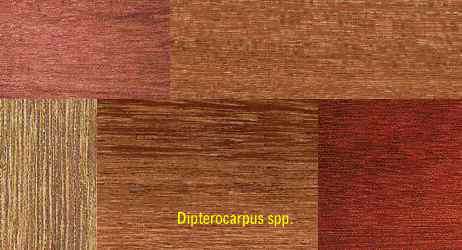
Eng (Dipterocarpus tonkinensis)
Family: Dipterocarpaceae
Common names: Angu, Apitong, Bebe, Dau, Eng, Heng, Huevos de gato, In, Keruing, Lagan, Lagunero, Mututi, Nogal falso, Palo de pollo, Pau sangua, Sangre, Sangre de drago, Sangrillo, Tro, Yang, Yaya sangre
Distributed in: Cambodia, China, Laos, Myanmar, Thailand, Vietnam (Oceania and S.E. Asia)
Distribution overview: Dipterocarps consists of more than 70 species scattered throughout the Indo-Malayan region. The wood of all species in the genus is almost identical in structure. Differences in weight, hardness, and color are no greater than those found within individuals of the same species growing in different areas. They are usually mixed and marketed together under the trade name of Apitong (from the Philippines) or Keruing (from Malaysia). Timbers from Malaysia are the most variable in properties.
Common uses: Beams, Boat building, Building construction, Cabin construction, Canoes, Concrete formwork, Construction, Core Stock, Crossties, Decks, Decorative plywood, Decorative veneer, Domestic flooring, Factory construction, Factory flooring, Figured veneer, Flooring, Form work, Foundation posts, Framing, Heavy construction, Joists, Lifeboats, Light construction, Pallets, Parquet flooring, Plain veneer, Plywood, Porch columns, Railroad ties, Rough construction, Shipbuilding, Structural plywood, Sub-flooring, Utility plywood, Veneer
Product sources: Some non-timber products include a somewhat viscous, liquid oleo-resin which is produced by some species in the genus. The resin is known as Minyak keruing in Malaysia and is used locally for caulking boats and for medicinal purposes. Pieces of rotten wood, well soaked in the resin are used as fire-lighters or torches.
Environment profile: Vulnerable
Tree size: Trunk diameter is 150-200 cm
Colors: the heart isPinkish tint, Reddish brownand the sapwoodWide, Yellow.The grain isStraight to shallowly interlocked, the textureModerately coarseand the lusterNon-lustrous
Natural durability: Susceptible to attack by marine borers, Susceptible to termite attack
Odor: Strong resinous smell associated with freshly cut wood
Silica Content: Contains silica
Some Dipterocarpus timbers contain silica in amounts that are generally less than 0.5% (of ovendry weight). A silica content of 0.05% is usually considered to be high enough to affect the machining properties of wood.
Kiln Schedules: T3 - D2 (4/4); T3 - D1 (8/4) US
Drying Defects: Drying at high temperatures may cause resin exudation, Warping can be expected
Ease of Drying: Thick Stock Requires Care
Blunting Effect: Moderate
Boring: Fairly easy to very easy
Carving: Fairly Easy to Very Easy
Cutting Resistance: Saw teeth blunted rapidly and severely by some stock
Gluing: Fairly difficult to glue
Mortising: good
Moulding: Fairly Easy to Very Easy
Movement in Service: Fairly Easy to Very Easy
Nailing: Satisfactory nailing properties, Very Good to Excellent
Planing: Straight grained and easy to work in most machining operations
Resistance to Impregnation: Sapwood is moderately resistant
Routing recessing: Fairly Easy to Very Easy
Sanding: Good sanding properties
Steam bending: Unsuitable
Screwing: Fairly Easy to Very Easy, Very Good to Excellent Results; Turning: Very Good to Excellent Results
Painting: High resin exudation makes painting/finishing difficult
Painting, staining, varnishing, and other surface finishing treatments are generally difficult because of high resin content in most Dipterocarpus timbers.
; Polishing: Very Good to Excellent; Staining: Very Good to Excellent;
- Numerical data Metric
- Numerical data English
- Strength properties
- References
 |
 |
 |
 |
| Item |
Green |
Dry |
Metric |
| Specific Gravity |
0,57 |
|
|
| Density |
|
737 |
kg/m3 |
| Bending Strength |
702 |
1261 |
kg/cm2 |
| Crushing Strength |
335 |
658 |
kg/cm2 |
| Hardness |
|
675 |
kg |
| Impact Strength |
|
|
cm |
| Shearing Strength |
|
|
kg/cm2 |
| Stiffness |
119 |
157 |
1000 kg/cm2 |
| Tangential Shrinkage |
|
|
% |
| Radial Shrinkage |
|
|
% |
| Weight |
|
|
kg/m3 |
| Maximum Load |
|
|
cm-kg/cm3 |
| Toughness |
|
270 |
cm-kg |
| Static Bending |
|
|
kg/cm2 |
|
 |  |  |  | | Item | Green | Dry | English | | Bending Strength | 9994 | 17939 | psi | | Density | | 46 | lbs/ft3 | | Hardness | | 1489 | lbs | | Maximum Crushing Strength | 4773 | 9359 | psi | | Stiffness | 1700 | 2244 | 1000 psi | | Toughness | | 235 | inch-lbs | | Specific Gravity | 0.57 | | | | Weight | 45 | 37. | lbs/ft3 | |
Chudnoff, M.,1984,Tropical Timbers of the World,U.S.A. Department of Agriculture, Forest Service, Forest Products,Laboratory, Madison.HMSO.1972.Handbook of Hardwoods, 2nd Edition.Revised by R.H. Farmer.Department of the Environment, Building Research Establishment, Princes Risborough Laboratory, Her Majesty's Stationery Office, London.Keating, W.G., Bolza, E.,1982,Characteristics properties and uses of timbers. South East Asia, Northern,Australia and the Pacific,C.S.I.R.O. Div. Chemical Technology,Inkata Press,1
|








